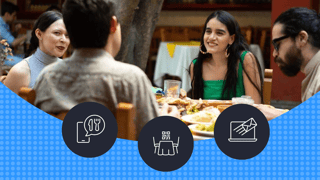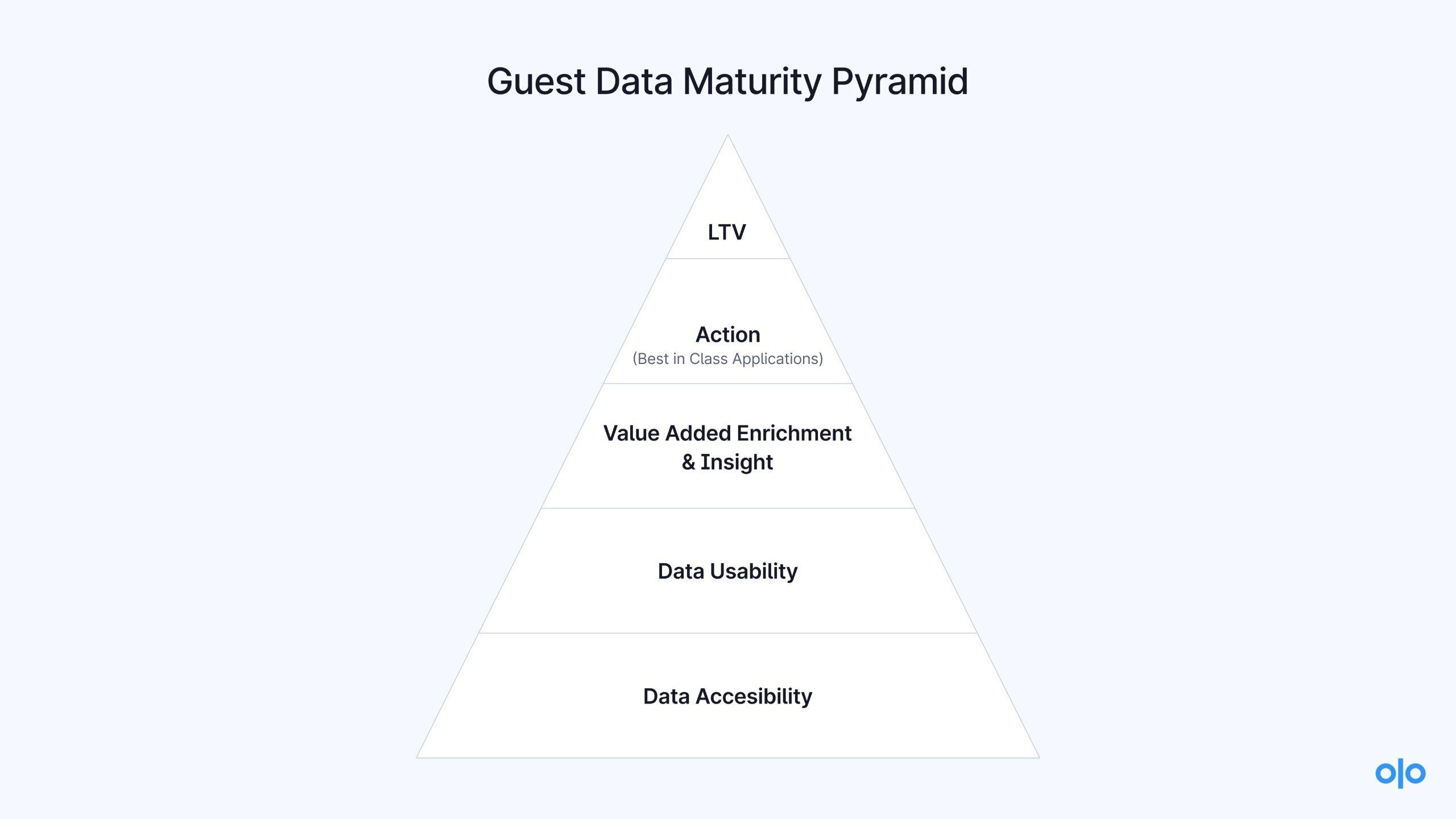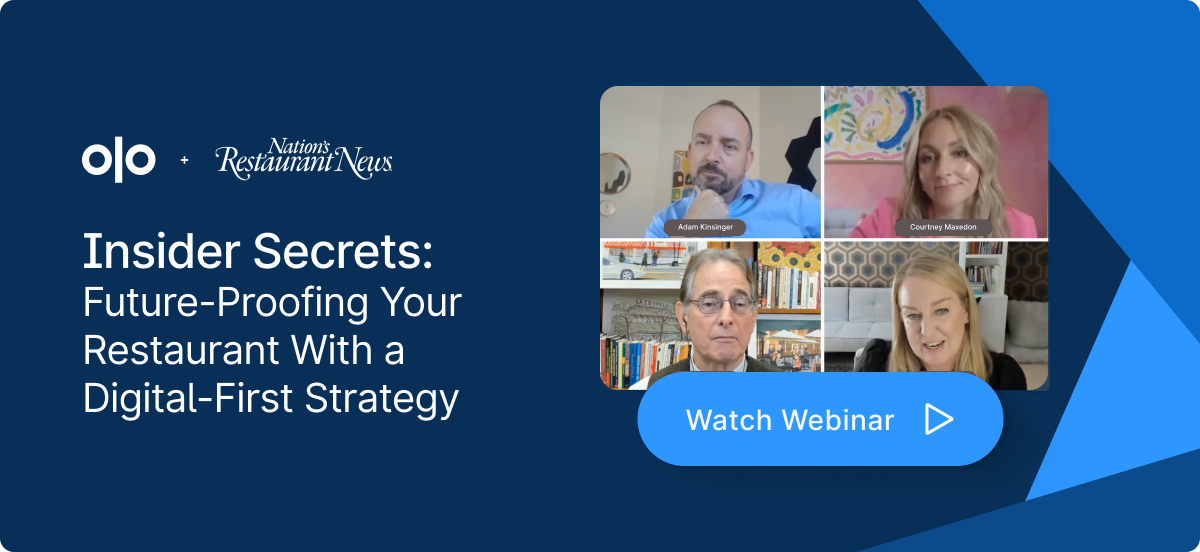
This article outlines:
Definitions of Customer Relationship Management (CRM) and Customer Data Platform (CDP)
The differences between CRM and CDP, as well as the benefits of each
Which is best for restaurants: CRM or CDP?
To help you make sense of the ever-evolving restaurant tech ecosystem and how it all works together to benefit restaurants, we’re breaking down two of the most talked-about newcomers to the restaurant tech stack: Customer Relationship Management (CRM) and Customer Data Platform (CDP).
At a high level, both of these tools are used to personalize the guest experience with cross-channel communications that are timely, relevant, and tailored to the behaviors of each individual. Though both can add tremendous value to businesses, they function very differently.
What is a CRM?
CRM stands for Customer Relationship Management. A standard CRM system collects data on a company’s direct guest interactions—like contact details and previous conversations—from a variety of communication channels, including their website, email, social media, and more. In other industries, sales teams utilize CRM systems to track and manage customer and prospect contact information, accounts, leads, and sales opportunities in one location.
Given that restaurants see thousands of guests per day, it would be unreasonable to expect operators to collect and store every nuanced guest data point by hand. A restaurant CRM like Olo’s eliminates that issue by connecting data from systems like your POS and online ordering solution as well as other custom-built (restaurant-specific) integrations—and making it actionable.
The action aspect of a CRM is not only critical but also differentiates solution providers. Every CRM has a unique set of actions you can take within the platform leveraging collected guest data—at minimum offering a way to create segments, engage guests via email, and so on. A restaurant CRM is built to take actions unique to engaging a restaurant guest like automating feedback surveys following an online order, incorporating offers into triggered email and SMS campaigns, and more.
In a nutshell, a CRM enables businesses to collect their guest contacts from select sources and organize them. And CRMs often also enable brands to communicate with their guests through integrated channels (e.g. via email)—and track those interactions over time.
What is a CDP?
CDP stands for Customer Data Platform. The Customer Data Platform Institute defines a CDP as: “packaged software that creates a persistent, unified customer database that is accessible to other systems.”
In general, a CDP connects all types and sources of customer data, including transactional, behavioral, profile, product, CRM, and offline, to create a single guest profile. Then, it can send that data to a myriad of destinations to make it usable.
A restaurant CDP like Olo’s Guest Data Platform creates individual guest profiles by connecting data from restaurant-centric systems including POS, loyalty programs, payment processors, reservations, guest feedback, mobile apps, online ordering, WiFi, waitlist, events, and e-commerce. It can then push that data to, again, restaurant-specific destinations like the host stand, menu engineering tools, real estate site selection vendors, a marketing automation solution, media channels, and the list goes on.
This gives every department—from marketing and finance to operations and culinary—a holistic view of guests, so they can sort, analyze, and act on those insights instantly.
The Main Differences Between CRM and CDP
Both Customer Relationship Management (CRM) and Customer Data Platform (CDP) solutions collect guest data for businesses. However, there are a few important differences.
- CDPs are designed to ingest massive amounts of data from a large number of sources. CRM data integrations tend to be more limited or require significant customization.
- CDPs dedupe guest records automatically, which is vital when the data is being piped in real-time to several external tools. CRMs are built to make use of guest records from directly within the system itself and often include reporting or audience-building filters manually controlled by the CRM admin.
- CRMs track known guests, whereas CDPs combine data from known contacts and reduce the number of anonymous profiles by connecting the dots between guest behaviors (e.g. a frequent diner could remain anonymous until their first online transaction—but their profile is zippered together with a unique credit card token)—to create a single source of truth.
- CDPs are not designed to take action to the end guest. Outside of data consolidation and identity resolution, CDPs only send data to external tools. CRMs, on the other hand, regularly have action baked in.
Which is Best For Restaurants: CRM or CDP?
There is no one-size-fits-all solution to optimizing a restaurant tech stack. There are numerous factors to consider including, but not limited to, overall business goals, budget, guest experience, operations, marketing, and beyond.
Restaurants can use the Guest Data Maturity Pyramid (Fig. 1) as a guide to determine which technology will best suit their business needs. Most brands start at the base of the pyramid to build the foundation of guest data architecture. At this stage, a brand may simply need data that is accessible and usable, in other words, a CRM.
As brands mature, they start to move up the pyramid. A CDP can help these brands with things like unifying and enriching guest profiles, gathering additional insights, piping data to other business intelligence tools, marrying data to financials, and leveraging lifetime value (LTV) throughout the organization.
It’s important to note that a CRM and CDP are not incompatible—more often than not, they’re interconnected. In fact, the best CRM for restaurants is one that can act as both a source and a destination for actionable data coming in through a CDP. For example, having your CRM and CDP connected would give you the ability to enrich guest data back into the CRM.

How Restaurants Can Benefit From a CRM
Good restaurant GMs and team members store personal details about regulars—favorite dishes, hobbies, family, etc.—in their heads. The problem is: It’s not scalable. They cannot easily share that information with other teams, especially corporate functions like marketing, culinary, or real estate. And to make matters worse, with staff turnover, those crucial guest details can be lost altogether.
A restaurant CRM eliminates those issues by collecting vital guest intel, along with contact information, communication history, and engagement channels, in one location so it’s never lost and can be accessed by others.
[Related: How tech can ease the FOH labor shortage]
Keep in mind that not all restaurant CRMs are created equal. Some are integrated with other tools—like waitlist, reservations, POS, and more—while others are more limited in functionality. Additionally, only some CRMs offer analytical capabilities that enable operators to segment guests or export data. And when it comes to actually acting on that data, some CRMs feature SMS or email marketing automation, while others do not.
Given that no two CRMs are built exactly the same, it’s important to thoroughly vet any solution before adding it to your restaurant tech stack in order to get the best bang for your buck.
How Restaurants Can Benefit From a Customer Data Platform
When restaurant brands are ready to do more with their guest data than a CRM can offer, they graduate to a CDP. A restaurant CDP can fuel the next phase of growth by making data more accessible to everyone, integrated with a wider-reaching set of sources, and actionable across an essentially unlimited number of destinations.
Restaurants often struggle to access their guest data due to archaic systems or limitations set by tech vendors. With a CDP, restaurants gain access to usable data from countless sources—online and offline—merged into a single guest record. Here are just a few of those sources:
- Waitlist and Reservations
- POS
- Online Ordering
- Pay at Table
- Payment Stack
- Loyalty
- Guest App
- Email/SMS
- WiFi
- Brand Website
- Social Media
- Surveys
Even brands that have access to their guest data typically do not have the team or the technology to stitch it all together. And systems that strictly unify data add another layer of costs. Some of the primary benefits of a restaurant CDP are that it eliminates data deserts, manual workflows, tech-stack dependency, and vendor lock-in.
With a CDP, restaurants can push a singular, enriched guest record to the destination vendor best suited to meet the brand’s business goals, including marketing, business insights tools, or data warehouses. For example, brands can use lifetime guest data to tailor email and SMS marketing efforts, as well as search and social advertising, with conditional messaging that drives guests through the funnel based on their engagement.
Through unifying and enriching guest profiles, a CDP can tell a brand exactly where and why guests spend money. By piping data to business intelligence tools and using the lifetime value (LTV) metric, brands can quantify the results of marketing dollars spent, staff training, menu optimization, real estate selection, etc.—and make strategic business decisions based on the behaviors and preferences of high-value guests.
CRM and CDP are not mutually exclusive. Each works with the other to provide a holistic view of the guest.
Still on the Fence?
If you’re still unsure of which solution is right for your restaurant brand, you’re not alone. For some, the data accessibility that a CRM provides is enough to satisfy their business needs. For others, the extra layer of data integration and flexibility that a CDP offers will be key to growth.
The truth is, that a CRM and CDP are not mutually exclusive. Each works with the other to provide a holistic view of the guest.
With a restaurant CDP, specifically designed to integrate with (often antiquated) POS systems, brands finally have the option to move up the Guest Data Maturity Pyramid and maximize lifetime value with enriched, actionable guest data.
In the end, restaurant brands that invest in technology that harnesses data—and act on it—will provide the best guest experience, edge out the competition, and build a profitable future.
Contact us to discover how a CRM and/or a CDP like Olo’s Guest Data Platform—purpose-built for restaurants—can help set your brand up for success.

Main Photo Credit: Los Muertos Crew from Pexels
